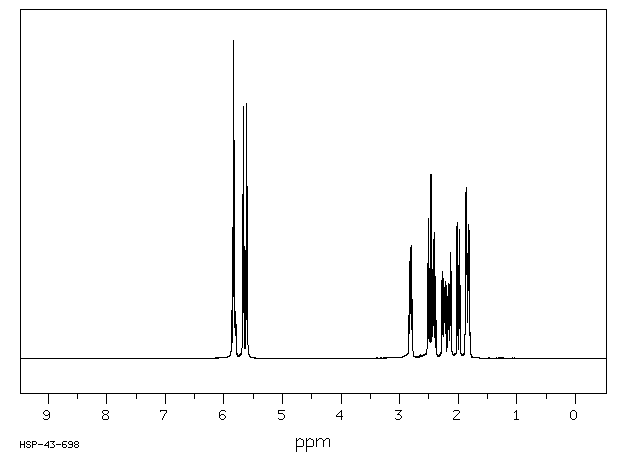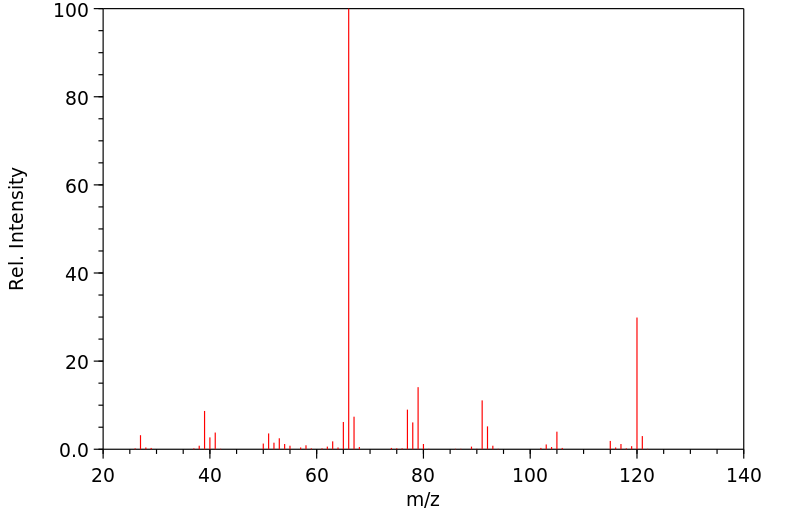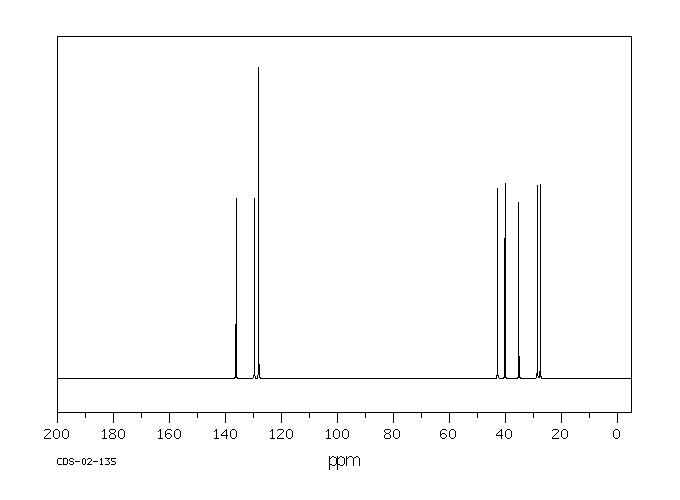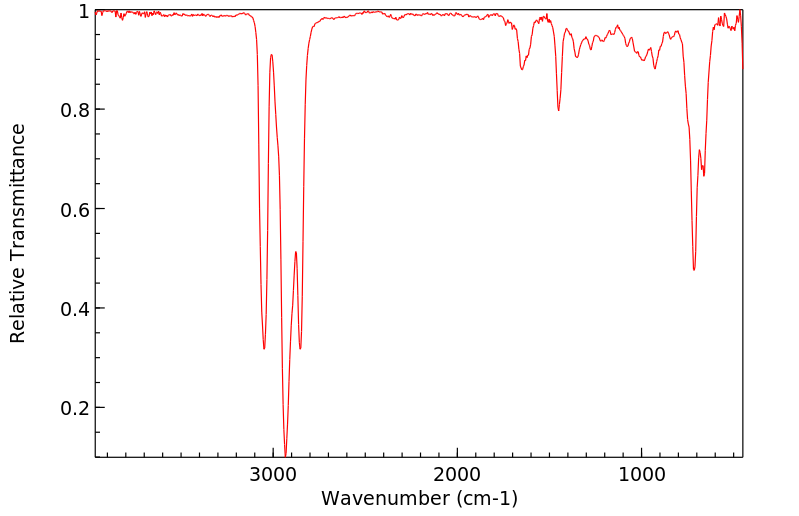3a,4,7,7a-四羟基茚 | 3048-65-5
中文名称
3a,4,7,7a-四羟基茚
中文别名
四氢茚;3A,4,7,7A-四氢茚
英文名称
bicyclo[4.3.0]nona-3,7-diene
英文别名
3a,4,7,7a-tetrahydro-1H-indene;3a,4,7,7a-tetrahydroindene;tetrahydroindene;Bicyclo<4.3.0>nona-3,7-dien;cis-bicyclo<4.3.0>nona-3,7-diene;3a,4,7,7a-Tetrahydro-inden;4,7,8,9-Tetrahydroinden;Tetrahydroinden
CAS
3048-65-5
化学式
C9H12
mdl
MFCD00021227
分子量
120.194
InChiKey
UFERIGCCDYCZLN-UHFFFAOYSA-N
BEILSTEIN
——
EINECS
——
-
物化性质
-
计算性质
-
ADMET
-
安全信息
-
SDS
-
制备方法与用途
-
上下游信息
-
文献信息
-
表征谱图
-
同类化合物
-
相关功能分类
-
相关结构分类
物化性质
-
沸点:158-160°C
-
密度:0,93 g/cm3
-
闪点:38°C
-
物理描述:Liquid
-
保留指数:952
-
稳定性/保质期:
遵循规定使用和储存,则不会发生分解。
计算性质
-
辛醇/水分配系数(LogP):2.6
-
重原子数:9
-
可旋转键数:0
-
环数:2.0
-
sp3杂化的碳原子比例:0.555
-
拓扑面积:0
-
氢给体数:0
-
氢受体数:0
安全信息
-
TSCA:Yes
-
危险等级:3
-
危险类别码:R10,R65
-
危险品运输编号:UN 3295
-
RTECS号:NK8750000
-
包装等级:III
-
危险类别:3
-
安全说明:S16,S23,S36/37,S62
-
储存条件:存于阴凉干燥处
SDS
Section I.Chemical Product and Company Identification
Chemical Name 3a,4,7,7a-Tetrahydroindene
Portland OR
Synonym Bicyclo (4,3,0)nona-3,7-diene
Chemical Formula C9H12
CAS Number 3048-65-5
Section II. Composition and Information on Ingredients
Chemical Name CAS Number Percent (%) TLV/PEL Toxicology Data
3a,4,7,7a-Tetrahydroindene 3048-65-5 Min. 98.0 Not available. Rat LD50 (oral) 3730 mg/kg
Rabbit LD50 (dermal) 14,100 mg/kg
(GC)
Mouse LD50 (oral) 3500 mg/kg
Section III. Hazards Identification
Acute Health Effects No specific information is available in our data base regarding the toxic effects of this material for humans. However,
exposure to any chemical should be kept to a minimum. Skin and eye contact may result in irritation. May be harmful if
inhaled or ingested. Always follow safe industrial hygiene practices and wear proper protective equipment when handling
this compound.
CARCINOGENIC EFFECTS : Not available.
Chronic Health Effects
MUTAGENIC EFFECTS : Not available.
TERATOGENIC EFFECTS : Not available.
DEVELOPMENTAL TOXICITY: Not available.
There is no known effect from chronic exposure to this product. Repeated or prolonged exposure to this compound is
not known to aggravate existing medical conditions.
Section IV. First Aid Measures
Eye Contact Check for and remove any contact lenses. DO NOT use an eye ointment. Flush eyes with running water for a minimum
of 15 minutes, occasionally lifting the upper and lower eyelids. Seek medical attention. Treat symptomatically and
supportively.
Skin Contact If the chemical gets spilled on a clothed portion of the body, remove the contaminated clothes as quickly as possible,
protecting your own hands and body. Place the victim under a deluge shower. If the chemical touches the victim's
exposed skin, such as the hands: Gently and thoroughly wash the contaminated skin with running water and non-abrasive
soap. Be particularly careful to clean folds, crevices, creases and groin. Cover the irritated skin with an emollient. Seek
medical attention. Treat symptomatically and supportively. Wash any contaminated clothing before reusing.
Inhalation If the victim is not breathing, perform artificial respiration. Loosen tight clothing such as a collar, tie, belt or waistband. If
breathing is difficult, oxygen can be administered. Seek medical attention. Treat symptomatically and supportively.
Ingestion INDUCE VOMITING by sticking finger in throat. Lower the head so that the vomit will not reenter the mouth and throat.
Loosen tight clothing such as a collar, tie, belt, or waistband. If the victim is not breathing, administer artificial respiration.
Examine the lips and mouth to ascertain whether the tissues are damaged, a possible indication that the toxic material
was ingested; the absence of such signs, however, is not conclusive. Seek immediate medical attention and, if possible,
show the chemical label. Treat symptomatically and supportively.
Section V. Fire and Explosion Data
Not available.
Auto-Ignition
Flammability Combustible.
Flammable Limits
Flash Points Not available.
Not available.
Combustion Products These products are toxic carbon oxides (CO, CO 2).
Fire Hazards
No specific information is available regarding the flammability of this compound in the presence of various materials.
Explosion Hazards Risks of explosion of the product in presence of mechanical impact: Not available.
Risks of explosion of the product in presence of static discharge: Not available.
No additional information is available regarding the risks of explosion.
Continued on Next Page
3048- 3a,4,7,7a-Tetrahydroindene
Fire Fighting Media
SMALL FIRE: Use DRY chemicals, CO 2, water spray or foam.
and Instructions LARGE FIRE: Use water spray, fog or foam. DO NOT use water jet.
Section VI. Accidental Release Measures
Spill Cleanup Flammable liquid.
Keep away from heat and sources of ignition. Mechanical exhaust required. Stop leak if without risk. Absorb with DRY
Instructions
earth, sand or other non-combustible material. DO NOT touch spilled material. Prevent entry into sewers, basements or
confined areas; dike if needed. Eliminate all sources of ignition. Consult federal, state, and/or local authorities for
assistance on disposal.
Section VII. Handling and Storage
FLAMMABLE. Reactive with strong oxidizers; may be ignited by heat, sparks, or flames. Vapors may travel to source of
Handling and Storage
ignition and flash back. Tightly seal container and store in a cool place. Closed containers may explode from heat of a
Information
fire. Empty containers may pose a fire risk. Evaporate residue under a fume hood if possible. Ground all equipment
containing material. Keep away from heat and sources of ignition. Mechanical exhaust required. Avoid excessive heat
and light. Do not breathe gas, fumes, vapor or spray. In case of insufficient ventilation, wear suitable respiratory
equipment. If you feel unwell, seek medical attention and show the label when possible. Treat symptomatically and
supportively. Avoid contact with skin and eyes.
Always store away from incompatible compounds such as oxidizing agents.
Section VIII. Exposure Controls/Personal Protection
Provide exhaust ventilation or other engineering controls to keep the airborne concentrations of vapors below their
Engineering Controls
respective threshold limit value. Ensure that eyewash station and safety shower is proximal to the work-station location.
Personal Protection Splash goggles. Lab coat. Vapor respirator. Boots. Gloves. A MSHA/NIOSH approved respirator must be used to avoid
inhalation of the product. Suggested protective clothing might not be sufficient; consult a specialist BEFORE handling
this product.
Exposure Limits
Not available.
Section IX. Physical and Chemical Properties
Physical state @ 20°C Liquid. Solubility
Not available.
0.93
Specific Gravity
Molecular Weight 120.19 Partition Coefficient
Not available.
Boiling Point Vapor Pressure
160°C (320°F) Not available.
Not available. Not available.
Melting Point Vapor Density
Refractive Index Not available. Volatility Not available.
Critical Temperature Not available. Odor Not available.
Viscosity Not available. Taste Not available.
Section X. Stability and Reactivity Data
Stability
This material is stable if stored under proper conditions. (See Section VII for instructions)
Conditions of Instability
Avoid excessive heat and light.
Incompatibilities
Reactive with oxidizing agents.
Section XI. Toxicological Information
RTECS Number NK8750000
Routes of Exposure Eye contact. Inhalation. Ingestion.
Toxicity Data Rat LD50 (oral) 3730 mg/kg
Rabbit LD50 (dermal) 14,100 mg/kg
Mouse LD50 (oral) 3500 mg/kg
CARCINOGENIC EFFECTS : Not available.
Chronic Toxic Effects
MUTAGENIC EFFECTS : Not available.
TERATOGENIC EFFECTS : Not available.
DEVELOPMENTAL TOXICITY: Not available.
There is no known effect from chronic exposure to this product. Repeated or prolonged exposure to this compound is not
known to aggravate existing medical conditions.
Acute Toxic Effects No specific information is available in our data base regarding the toxic effects of this material for humans. However,
exposure to any chemical should be kept to a minimum. Skin and eye contact may result in irritation. May be harmful if
inhaled or ingested. Always follow safe industrial hygiene practices and wear proper protective equipment when handling
this compound.
Continued on Next Page
3a,4,7,7a-Tetrahydroindene
Section XII. Ecological Information
Ecotoxicity Not available.
Environmental Fate Not available.
Section XIII. Disposal Considerations
Recycle to process, if possible. Consult your local or regional authorities. You may be able to dissolve or mix material with
Waste Disposal
a combustible solvent and burn in a chemical incinerator equipped with an afterburner and scrubber system. Observe all
federal, state, and local regulations when disposing of this substance.
Section XIV. Transport Information
DOT Classification CLASS 3: Flammable liquid.
PIN Number
Proper Shipping Name
Hydrocarbons, liquid, n.o.s.
Packing Group (PG) II
DOT Pictograms
Section XV. Other Regulatory Information and Pictograms
TSCA Chemical Inventory This product is ON the EPA Toxic Substance Control Act (TSCA) inventory.
(EPA)
WHMIS Classification
Not controlled under WHMIS (Canada).
(Canada)
EINECS Number (EEC) Not available.
EEC Risk Statements Not available.
SECTION 16 - ADDITIONAL INFORMATION
N/A
上下游信息
-
上游原料
中文名称 英文名称 CAS号 化学式 分子量 二聚环戊二烯 bi(cyclopentadiene) 77-73-6 C10H12 132.205 —— 5-Vinyl-bicyclo<2.2.1>hepten-2 25093-48-5 C9H12 120.194 —— endo-vinylnorbornene 23890-32-6 C9H12 120.194 5-乙烯基双环[2.2.1]庚-2-烯 5-vinyl-2-norbornene 3048-64-4 C9H12 120.194 -
下游产品
中文名称 英文名称 CAS号 化学式 分子量 —— 3a,4,7,7a-Tetrahydroinden 6731-20-0 C9H14 122.21 —— bicyclo<4.3.0>non-3,4-ene 16613-73-3 C9H14 122.21
反应信息
-
作为反应物:描述:3a,4,7,7a-四羟基茚 在 palladium on activated charcoal η5-C9H11Fe(CO)2(isobutylene)+BF- 、 氢气 、 sodium iodide 作用下, 生成 3a,4,7,7a-Tetrahydroinden参考文献:名称:η5-C9H11Fe(CO)2(异丁烯)+BF4-复合物作为碳-碳双键的保护基团摘要:制备了 η5-C9H11Fe(CO)2(异丁烯)+BF4− (6), [Fpi(异丁烯)]+BF4−,并将其用作碳-碳双键的保护基团。配合物 6 与多种二烯烃进行配体交换,得到 Fpi(二烯烃)+BF4- 配合物,其随后在 Pd/C 上的氢化得到区域选择性氢化的烯烃。DOI:10.1246/bcsj.56.2861
-
作为产物:参考文献:名称:BOBYLEVA A. A.; BELIKOVA N. A.; KALINICHENKO A. N.; BARYSHNIKOV A. T.; DU+, ZH. ORGAN. XIMII, 1980, 16, HO 8, 1645-1653摘要:DOI:
文献信息
-
Liquid-phase synthesis of cyclic diene diepoxides using metal halides and hydrogen peroxide作者:Kh. M. Alimardanov、O. A. Sadygov、N. I. Garibov、M. Ya. AbdullaevaDOI:10.1134/s1070428012100077日期:2012.10Optimal conditions were found for induced hydroxyhalogenation of cyclic dienes (tetrahydroindene, 4-vinylcyclohexene and 5-vinyl- and 5-cyclohexenylbicyclo[2.2.1]hept-2-enes) in the system [MHlg-HA or HHlg]-H2O2 (or NaClO). Dehydrohalogenation of the chloro- and bromohydrins thus obtained with powdered potassium carbonate gave the corresponding diepoxy derivatives, and their hydrolysis led to mixtures
-
PROCESS FOR PRODUCING HIGH PURITY EXO-ALKENYLNORBORNENE申请人:Bell Andrew公开号:US20090054714A1公开(公告)日:2009-02-26Embodiments of the present invention are directed generally to methods for producing high purity exo-alkenylnorbornenes from a mixture of conformational isomers thereof.本发明的实施例通常涉及从共轭异构体混合物中生产高纯度的外部烯基去氢脱环戊烷。
-
Highly Selective Epoxidation of Cycloaliphatic Alkenes with Aqueous Hydrogen Peroxide Catalyzed by [PO<sub>4</sub>{WO(O<sub>2</sub>)<sub>2</sub>}<sub>4</sub>]<sup>3−</sup>/Imidazole作者:Keigo Kamata、Kosei Sugahara、Ryo Ishimoto、Susumu Nojima、Motoya Okazaki、Takaya Matsumoto、Noritaka MizunoDOI:10.1002/cctc.201402268日期:2014.8peroxotungstate, THA3[PO4WO(O2)2}4] (I, THA=tetra‐n‐hexylammonium), could act as an efficient catalyst for epoxidation of cycloaliphatic alkenes with 30 % aqueous hydrogen peroxide (H2O2). Compound I showed higher catalytic activity and selectivity to epoxide than other tungstates. By using the I/imidazole system, various kinds of cycloaliphatic alkenes could be highly selectively converted into the
-
一种安全环保可控的双环氧化物的合成工艺
-
METHOD FOR PRODUCING EPOXY COMPOUND申请人:ENEOS CORPORATION公开号:US20210340118A1公开(公告)日:2021-11-04The invention provides a method for producing an epoxy compound by hydrogen peroxide using an organic compound having a carbon-carbon double bond as a raw material, wherein a by-product is suppressed from being generated and the epoxy compound is produced in a high yield. In particular, the invention provides a method for producing an epoxy compound involving oxidizing a carbon-carbon double bond in an organic compound with hydrogen peroxide in the presence of a catalyst, wherein the catalyst comprises a tungsten compound; a phosphoric acid, a phosphonic acid or salts thereof; and an onium salt having an alkyl sulfate ion represented by formula (I) as an anion: wherein R 1 is a linear or branched aliphatic hydrocarbon group having 1 to 18 carbons, which may be substituted with 1 to 3 phenyl groups.
表征谱图
-
氢谱1HNMR
-
质谱MS
-
碳谱13CNMR
-
红外IR
-
拉曼Raman
-
峰位数据
-
峰位匹配
-
表征信息
同类化合物
降冰片烯
金刚烷-D16
金刚烷
螺戊烷
螺二環己烷
螺[5.6]十二烷
螺[5.5]十一碳-4-烯
螺[5.2]辛-2-烯
螺[4.5]癸烷
螺[4.4]壬-8-烯
螺[3.4]辛烷
螺[3.4]辛-7-烯
螺[3.3]庚-2,5-二烯
螺[2.5]辛烷
螺[2.5]辛-7-烯
螺[2.5]辛-5,7-二烯
螺[2.4]庚-4,6-二烯
螺[2.4]庚-1-烯
螺[2.3]己-1-烯
螺[2.2]戊-1-烯
螺<二环<2.2.2>辛-5-烯-2,1'-环丙烷>
螺<4.4>壬-1,3,7-三烯
螺<4.4>壬-1,3,6,8-四烯
螺(4.4)壬烷
螺(4.4)壬-1,3-二烯
螺(3.4)辛-5,7-二烯
trans-perhydroazulene
萘烷
萘,1,2,3,4,4a,8a-六氢-,顺-
美罗培南中间体F9
篮烷
立方烷
氨基甲硫酸,二甲基-,O,O-(3,3-二甲基1,1-联苯基-2,2-二基)酯
棱晶烷
杜瓦苯
新戊基-1金刚烷
抗氧化剂TH-CPL
庚搭烯
四螺[2.0.2:0.2:0.2:0]十二烷
四螺[2.0.0.0.2.1.1.1]十一烷,顺-
四环己基铅
四环[5.3.0.0<2,6>.0<3,10>]癸-4,8-二烯
四环[5.3.0.0(2,6).0(3,10)]癸烷
四环[4.4.0.02,10.03,7]癸-4,8-二烯
四环[4.2.2.26,5.01,6]十二烷
四环[4.2.0.02,5.03,8]辛烷
四环[3.3.0.02,4.03,6]辛-7-烯
四环<5.3.1.02,6.04,9>十一烷
四环(8.2.2.22,5.26,9)十八碳-1,5,9-三烯
四环(4.1.0.0(2,4).0(3,5))庚烷










